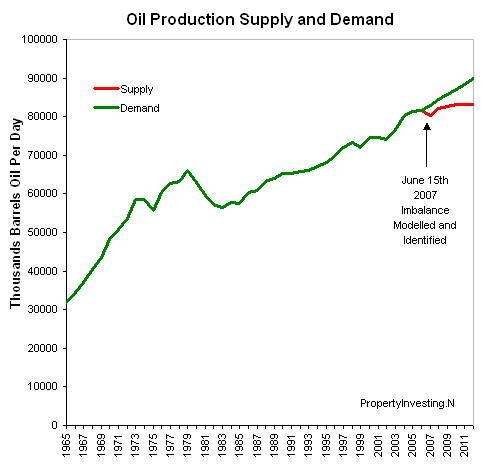|
|
|
|
|
EnergyInsights.net team
We have performed an analysis of the historical production of all oil producing countries. We then went through every country and have predicted the actual maximum reasonable production rate they can achieve from mid 2007 until 2012 - using our expert knowledge. We then overlay the EIA official global oil demand forecast issued in July 2007. What we came up with was a surprising and one could describe as disturbing imbalance - starting this year. The gap between supply and demand widens from early 2007 onwards. Global oil production peaks at 83 million bbls/day in 2010 to 2012 and stays more of less flat for a 3-5 year period. Meanwhile, demand is forecast to rise by the EIA by an additional 1.37 million bbls/day from 2006 up until 2010, and then an additional 1.32 million bbls/day after 2010 up until 2015 - using current GDP projections and economic forecasts.
 Obviously this imbalance implies oil prices will shoot up – probably to $100/bbl and then $125/bbl – which would then start to constrain demand - but we believe it will require oil prices well over $100/bbl to have a material impact on demand. Transport fuels (diesel) is a key driver - and there is no reasonable alternative to the combustion engine at present.
Obviously this imbalance implies oil prices will shoot up – probably to $100/bbl and then $125/bbl – which would then start to constrain demand - but we believe it will require oil prices well over $100/bbl to have a material impact on demand. Transport fuels (diesel) is a key driver - and there is no reasonable alternative to the combustion engine at present.
Those "Doubting Thomases" will say that the oil price has dropped from $78/bbl end July to $71/bbl on 10th August 2007 – what we say is this is a temporary speculative selling by hedge funds reducing there positions before the biggest oil price hike you will ever see starts in September 2007 lasting years.
The "Doubting Thomases" will also say –
These higher oil prices will lead to:
· Increase food prices – for transportation. Also, land shortages cause by the transfer of crops from food to corn & sugar for ethanol production (e.g. US mid-west and
· Lower global GDP growth rates of ca. 0.5 to 1.0% (high oil prices act like a tax – a drag on economic activity)
· Booming oil towns around the world where huge wealth will be created
· Higher stock market valuation for oil companies and oil services companies - lower stock market valuations for energy intensive businesses (e.g. heavy manufacturing)
· Increases in interest rates – and therefore reduction in asset prices of property
Our chart is truly unique – we have the back-up data for every country to support our predictions - we intend to update the annually, or if other data comes in. Some of the key countries production forecasts we have are outlined in the table below, for your review:
Oil Production Forecast - some key countries
Thousand barrels daily
2005
2006
2007
2008
2009
2010
2011
2012
USA
6895
6871
6734
6599
6467
6338
6211
6087
Canada
3041
3147
3272
3403
3539
3681
3791
3867
Mexico
3760
3683
3609
3537
3466
3397
3329
3263
Venezuela
2937
2824
2782
2740
2699
2658
2618
2579
Norway
2969
2778
2639
2507
2382
2263
2150
2042
Russian Federation
9552
9769
9818
9867
9917
9966
10016
10066
United Kingdom
1809
1636
1538
1446
1359
1277
1201
1129
Iran
4268
4343
4343
4343
4343
4343
4343
4343
Iraq
1833
1999
2000
2000
2000
2000
2000
2000
Kuwait
2643
2704
2758
2813
2870
2927
2956
2956
Saudi Arabia
11114
10859
9200
11000
11000
11000
11000
11000
United Arab Emirates
2751
2969
3177
3399
3637
3819
3876
3876
Nigeria
2580
2460
2460
2460
2460
2460
2460
2460
China
3627
3684
3684
3684
3684
3684
3684
3684
India
784
807
807
807
807
960
1000
1000
60562
60532
58820
60605
60629
60773
60635
60352
Now you should have a better insight into when the next oil price shock will occur - and do not be surprised to see one develop in the next few years. And if you expect to find the above chart or data anywhere else - I think you'll be disappointed. It's taken years of analysis to get this in the correct format to present to you. We do not have a crystal ball - but we have a good track record for economic predictions – do not be surprised if oil prices are over $100/bbl next year and beyond. The only thing likely to stop this rise is a recession in Europe and the
We hope you have found these insights and supporting analysis and predictions helpful.
If you have any comments on the analysis, predictions or insights, please contact us on enquiries@energyinsights.net.